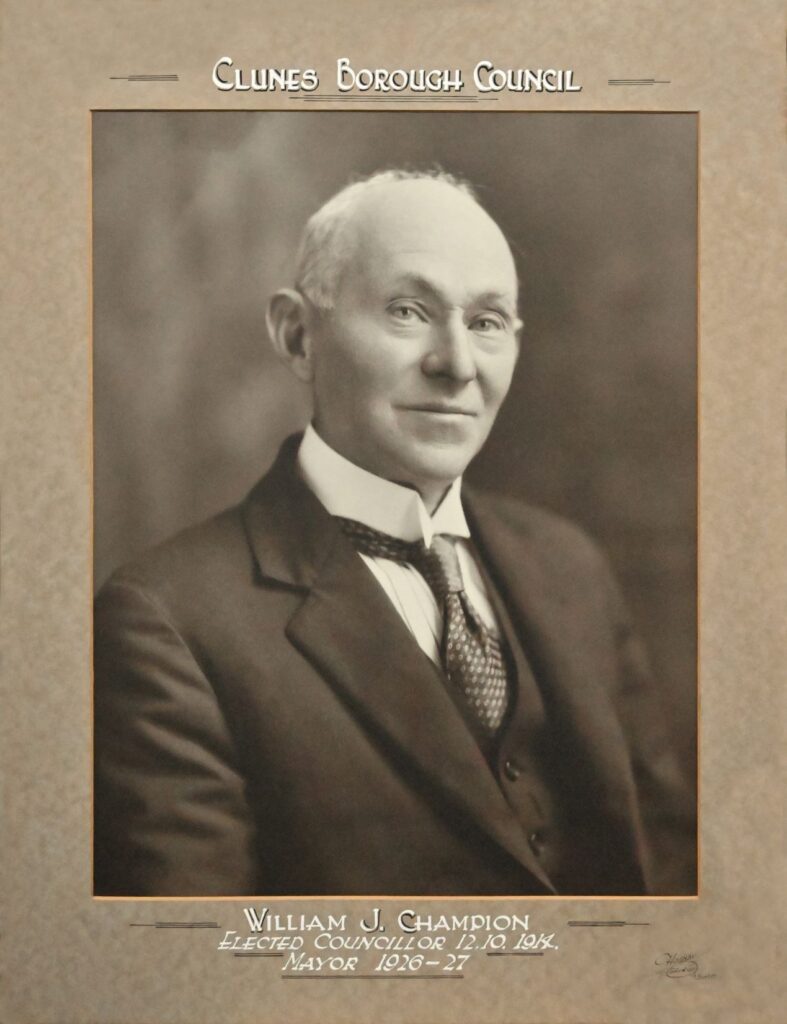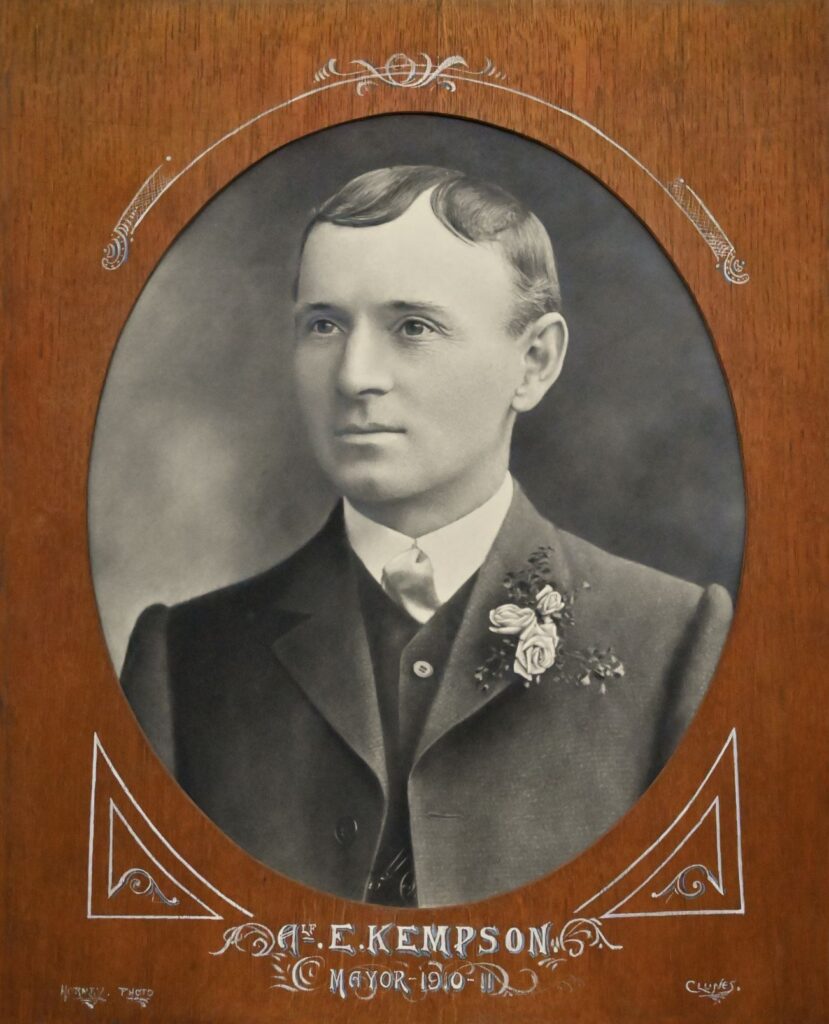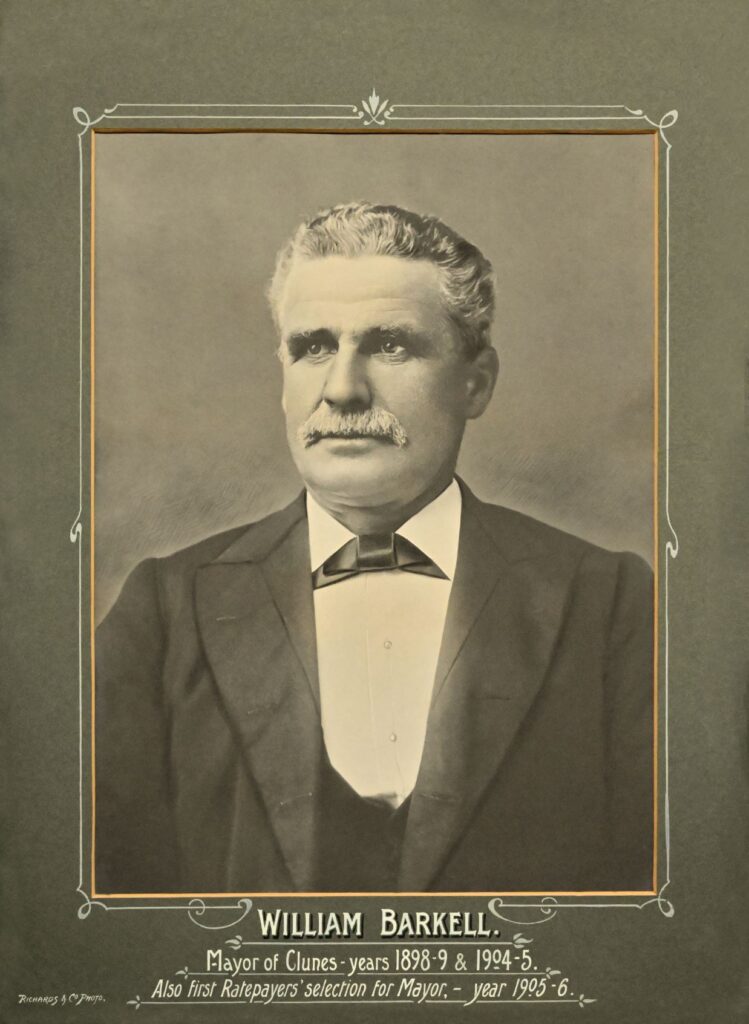Presented herewith is a brief summary of the early history of the town; the events leading to Clunes being declared a Municipality, and some of the major events, and crises encountered by the Borough Council in the 105 years of its existence.
Donald Cameron, a Scot of 21 years, established his home on the bend of the creek, nearly ½ mile downstream from the ford, at the foot of Camp Hill. He named the place Clunes, after his home in Scotland. Following the discovery of gold by William Campbell in 1850, and James Esmond’s report of obtaining gold in the district in 1851, there was a rush of gold-seekers to Clunes.
At this time, Clunes came under the jurisdiction of the Creswick Road Board which had a large district to administer and consequently Clunes did not receive the attention it required. In July 1859, a petition was sent to the Government, requesting separation from Creswick Road Board, and for the formation of a Road Board for Clunes. In October 1859 a club to look after the interests of Clunes was formed. It was named the ‘Clunes Commercial Club’, and many of the prominent men of the town were members. The Club took a great deal of interest in the affairs of the town, and among many items discussed was the formation of a ‘Hook-and-Ladder Brigade’ to fight fires. (The Clunes Volunteer Fire Brigade was not formed until 1862). The Club took steps to have Clunes proclaimed a Municipality and thereby independent of Creswick Road Board. A petition was submitted to the Government in August 1860.

On 26 October 1860, Creswick Advertiser proclaimed: ‘Clunes is now a Municipal district’. A list of prospective candidates for the Council was drawn up and a meeting of land-holders was called for Tuesday, 13th November 1860.
At this meeting the list of proposed candidates was decided upon, and the election was held next day. The number of councillors was to be seven, and the Councillors should receive no remuneration. The following were elected:
Thomas Symons
Samuel Connell
Pattison Mark (Chairman)
William Rose
Robert Morrison
Alexander Nicholls
Wiliam Gubbins
Mr. J Hoare-Smith was appointed Town Clerk, and Surveyor for twelve months, at a salary of £210 per annum. Rates were assessed at 1/6 in the £1.
By-laws to assist in running the town were drawn up and submitted for approval. A grant was applied for to build a bridge over Creswick Creek, near the corner of Fraser and Bailey Streets. Application was made for a grant of land for Municipal purposes, and the land on which the Town Hall and courthouse, and the Police Station now stand was granted.
A seal was ordered with the Royal Arms within a shield, supported by a Kangaroo and Emu. It also shows a plough and battery stamps, with mottoes, ‘Speed the Plough’ and ‘Success’, surrounded by a band having the inscription: ‘Municipality of Clunes, Incorporated 1860’.

The majority of councillors carried out their work very well, but a few individuals appear to have had a good deal to say, and some upset proceedings a great deal. A study of the Minute Books of the Borough Council reveals a good deal of the town’s history, but many items appear to which there is no sequel leaving so much unanswered. By-laws to assist in running the town were drawn up, and submitted for approval.
As early as 1861, goats were apparently becoming a nuisance, for, in October, a By-law covering the ‘Nuisance of Goats and Pigs being allowed to go at large’ was made. In March 1869 the Pound-keeper reported that 392 goats had been impounded:10 had been released, 2 escaped and 380 had been destroyed.
There was also a report about ‘wandering geese’. Later, ‘wandering cows’ were a nuisance. Complaints about thistles appear very early in the minute books.
Trouble caused by insufficient closets and cess-pits being close to wells used for water supplies, was frequently mentioned, but it was not until1899 that a properly controlled sanitary system was established.
There were a number of epidemics with Typhoid, Diptheria and Scarlet Fever reported. In May 1876, the Health officer reported that there had been 150 cases of Scarlet Fever in the Borough, 12 of them fatal. In July 1883, it was reported that there had been 299 cases of Typhoid fever, with 3 deaths. By August 1883, the water supply was considered to be the culprit. By this time there had been 315 cases with 14 deaths.
July 1844 77 cases of Typhoid Fever with 3 deaths
October 1870 56 cases of Diptheria with 12 deaths
February 1893 150 cases of Measles in 1892
1897 85 cases of Scarlet Fever and 21 cases of Diptheria
1898 13 Typhoid, 1 Scarlet Fever
1899 57 cases of Typhoid, none fatal, and 8 cases of Scarlet Fever.
1900 3 cases of Typhoid
1901 No infectious cases in the Borough
1908 10 cases Diptheria, 2 cases Typhoid fever.
1909 11 cases Diptheria, 2 cases Typhoid fever.
1910 12 cases Diptheria and 5 of Scarlet Fever.
1912 There were several cases of Diptheria.
In later years very few cases of contagious diseases were reported.
In 1868, a Water Committee was formed with representatives from the Council and the various Mining Companies, with the purpose of obtaining a water supply for the town. After Several months all the Mining Companies, with the exception of the New North Clunes Gold Mining Company, withdrew from the scheme. The Clunes Water Commission was formed, and the New North Clunes Company guaranteed the sum of £40,000. Mr Peter Lalor, M.P., was appointed chairman and the Council and the Mining Companies were represented.
A reservoir was built on Birch’s Creek at Newlyn, and a catchment weir on Birch’s Creek at Lawrence. The water was then taken by a water-race to the settling basin and the pipe-head, about one mile from the reservoir. This work was done with the money subscribed by the Government, and the New North Clunes Company. The Council was approached on several occasions to purchase the scheme, but it was not until February 1874 that the Council purchased the water works scheme for £60,000. The scheme was administered by the Clunes Water Supply Commission, formed from the whole council and the mayor of each year was to be Chairman.

In August 1864, the Council was enlarged to nine members, and the position of Chairman was changed to that of Mayor. Cr C T Sutherland, who had been Chairman for 1862 and 1863 was elected to be the first Mayor.
Up to this time, the Council elections were held in November, but from 1864 on, Councillors were elected in August, and took their seats in September. However the Mayor was still elected in November, until 1875, when the Mayor was elected at the September meeting after the elections.
The Council was conscious from the early days of the need to plant trees to beautify and improve the town. Photographs taken in 1859, 1862 and 1866, show the town with no trees at all. The line of trees above the creek was planted in 1880. The trees on the hillside in Victoria Park (The Rocks) were first planted in 1906. It is owing to the efforts of the Council and Clunes Citizens that Clunes has many mature trees still in these locations.
During 1869, the disastrous floods devastated the town, Fraser St was flooded. There was between 3 and 4 feet of water at the Templeton Street intersection, and 7 to 8 feet at Camp Hill corner. This was followed by a similar flood in 1870.
In 1869, the Council applied to the Government for a grant to be spent in widening and deepening the creek. Up to that time, the creek flowed through a narrow meandering channel, and, as the sand from the mine batteries was passed into the creek, it was subject to overflow it banks with any floods. In 1872, money was made available and contracts were let to enlarge the Creek channel. The excavations were completed by the end of 1873 and the subsequent work was to consolidate the walls and lining with stone where necessary. The channel was widened to 56 feet and the depth was to 12 feet stretching from above the Government bridge to below the Camp Hill Ford.

Plans for a Town Hall and a Court House had been sent to the Government as early as 1870, and in December 1871 approval was received for the Council to go ahead with building the Hall. At a special meeting on December 6th, the Town Clerk was instructed to write to Mr Percy Oakden, Architect of Ballarat Town Hall, asking him to submit plans for the Town Hall and Court House, including fittings at a cost not exceeding £3,000. The Foundation Stone was laid on 4th April 1872 and the Town Hall was opened by the Governor of Victoria, Sir George F Bowen, on 30th May 1873. The Clock was installed in July 1873.
During 1872, the Council had been negotiating with the Railway Department regarding the site for a Railway Station. Among many propositions, a site in Alliance Street, near Templeton Street, was favoured. Mr Higginbotham, Engineer in Chief, stated that he could not recommend the Alliance Street site. He recommended a site on Ballarat Road, as being more accessible. This site is where the Railway Station now stands. The first train for Clunes from Ballarat ran in November 1874.
In May 1874, the Council requested the Postal Department to erect a proper and commodeus brick building in place of the existing Post Office, which was in a bad state of repair, and very dilapidated. The Post Office was erected in 1879 – 80 and still stands on the corner of Bailey and Service Streets. It was stated that the excavation for the foundations reached a depth of 18 feet.

Through the years, many requests were made to the Council to provide Public Swimming Baths. Many suggestions were made and investigated, but nothing was done. The first Swimming Baths were established at the water reservoir of the South Clunes Mine in 1906. The walls of the pool were elevated above the surrounding land and consequently it needed little alteration. The pool was 66 ft by 66ft, and ranged from 2 ½ ft to 7 ft in depth. Outlet pipes were fitted and water was supplied from the town supply. The area was fenced and a dressing shed was provided. These baths were very popular with young men and boys of the town and many were taught to swim there. These baths were not suitable for mixed bathing, and in 1920 and 1921, a ‘Bath’s Committee’ converted an old water reservoir into proper swimming baths. These were situated on the hillside behind the Free Library. The pool was triangular and lined with concrete. Dressing sheds and a toddler’s pool was provided. After the 1939 – 45 War, it was decided to establish a Olympic type pool as a War Memorial. This was established in Victoria Park at the site of the current pool.
The peak of prosperity was reached in 1873, when the population of the Borough was 6,203, and the valuation of the rateable property was £170,936, and the estimated annual value was £21,367. The town had grown continuously since its formation but the main business section was situated in Lower Fraser Street between Templeton Street and Camp Hill. The Ratepayers Roll for 1870 showed that in Lower Fraser Street between Templeton Street and Camp Hill, there were 63 businesses, including 10 hotels, and a further 2 hotels on the other side of Camp Hill.
From 1880 onward, the yield of gold from the mines began to decline, until finally the larger quartz mines closed down in 1894 and 1895 and any gold mining done was on a very small scale. The era of gold-mining in Western Australia, which commenced about this time, attracted many of the male population away from Clunes, and other towns in Victoria. Some returned but many sent for their families to come to Western Australia. The result was that many towns simply faded out, as they solely depended on goldmining, and, in many cases, left no trace of what were once prosperous towns.
Clunes, which had good agricultural districts, managed to carry on, and with the development of local industries, managed to reach quite a degree of prosperity.
The Council minute books show that there were many periods of low finance, especially during the Depression of the 1890’s, the early 1900’s and the 1929-35 Depression. These must have been very difficult periods for the Borough Council, yet the town survived and prospered.
Clunes contributed its share in manpower, money, and patriotic effort during three Wars; the Boer War in South Africa, 1899 to 1902; WW1 1914-1818 War; WW11 1939-45.
The fire of 8th January 1944, which destroyed Clunes District Hospital, and 15 homes in the town at north Clunes and the eastern part of the town was a great blow, but it was not long before new homes were provided for those who’d lost their homes and a new Hospital was built and equipped.
Through many trials and tribulations Clunes Borough Council and Clunes citizens have succeeded in carrying on, and it is considered that it was due to their efforts that Clunes was handed over to the new Council – The Talbot and Clunes Shire Council – as a financially stable and valuable asset.

Images: A selection of the Mayors of Clunes Borough between 1860 and 1965. The original images are held by the Clunes Museum.

